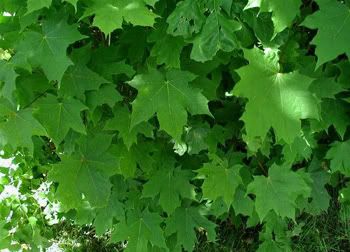
Norway Maple Leaves
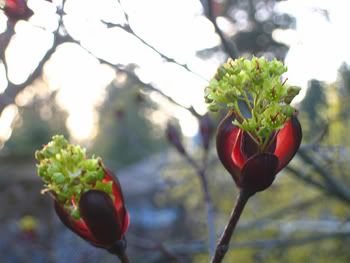
Norway Maple Buds
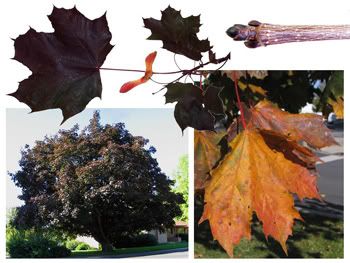
The Crimson King Variety of the Norway Maple
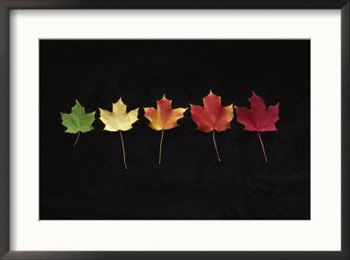
Color Progression of a Norway Maple Leaf Changing in Autumn
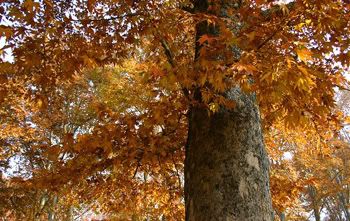
Norway Maple Tree in Autumn
Three months after I was born, my parents moved us from Northwest Detroit to the suburb of Oak Park. It was March, 1965. Later that spring, my mother noticed a lot of maple seedlings in our yard. She carefully replanted the seedlings in pots, and that summer planted the strongest seedling in the yard. "That is your tree," she told me when I was old enough to help her water plants in the yard a few years later. "I planted that tree for you right after you were born," she said.
From that time forward, I took care of that tree and always made sure it was watered and fertilized, and it grew strong and fast. Five years later, we moved from the house in Oak Park to the suburb of West Bloomfield, but this Maple was my tree. We were NOT going to leave it behind. So my father dug it out of the ground. It was a strong tree, about three feet high with a trunk about an inch think. We planted that tree in the backyard of our new home, along with a more mature Crimson King Maple that was about ten feet tall my father bought from the Nursery, and a few other trees and shrubs.
Well I continued to take care of my Norway Maple Tree. I made sure it was always watered, and it continued to grow. I broke my heart when my parents were divorced and we had to sell the house in 1978. This time, we couldn't take the tree with us. In 1978, only 13 years later, this Norway Maple Tree was 25 feet high, and it's canopy of leaves contained a volume as large as half of our two-story house. It dwarfed every other tree on the lot, including the Crimson King varietal that had a 7 foot head start on it.
Today, 43 years later, that Norway Maple is three times as high as our old house, which probably makes it 75 feet tall, and if it were laid out on the ground, it would take up the entire backyard, easily covering more volume than the house. It's that big. And it's that strong. And it's still my tree.
Below are some facts about Norway Maples from Wikipedia. I recommend growing them from seed in Potting Soil for the first three years. Water them well, and they will become the tallest, strongest, most beautiful trees in your yard.
___________________________________________
Acer platanoides (Norway Maple) is a species of maple native to eastern and central Europe and southwest Asia, from France east to Russia, north to southern Scandinavia and southeast to northern Iran.
The Norway Maple is a deciduous tree growing 50-100 feet tall with a trunk up to 5 feet in diameter with a broad, rounded crown. The bark is grey-brown and shallowly grooved; unlike many other maples, mature trees do not tend to develop a shaggy bark. The shoots are green at first, soon becoming pale brown; the winter buds are shiny red-brown. The autumn colour is usually yellow, occasionally orange-red. The flowers are in corymbs of 15–30 together, yellow to yellow-green with five sepals and five petals 3–4 mm long; flowering occurs in early spring before the new leaves emerge. The fruit is a double samara with two winged seeds, the seeds are disc-shaped, strongly flattened, 10–15 mm across and 3 mm thick. The wings are 3–5 cm long, widely spread, approaching a 180° angle. It typically produces a large quantity of viable seeds. It is not particularly a long-lived tree, with a maximum age of around 250 years.
The Norway Maple is a member of the section Platanoidea Pax, characterised by flattened, disc-shaped seeds and the shoots and leaves containing milky sap. Other related species in this section incluse Acer campestre (Field Maple), Acer cappadocicum (Cappadocian Maple), Acer lobelii (Lobel's Maple), and Acer truncatum (Shandong Maple). From Field Maple, Norway Maple is distinguished by its larger leaves with pointed, not blunt, lobes, and from the other species by the presence of one or more teeth on all of the lobes.
It is also frequently confused with the more distantly related Acer saccharum (Sugar Maple). Sugar Maple is easy to identify by clear sap in the petiole (Norway Maple has white sap). The tips of the points on Norway Maple leaves reduce to a fine "hair", while the tips of the points on Sugar Maple leaves are on close inspection rounded. On mature trees, Sugar Maple bark is more shaggy, while Norway Maple bark has small, often criss-crossing grooves. While the shape and angle of leaf lobes vary somewhat within all Maple species, the leaf lobes of Norway Maple tend to have a more triangular shape, in contrast to the more squarish lobes often seen on Sugar Maples. The seeds of Sugar Maple are globose, while Norway Maple seeds are flattened. Sugar Maple usually has a brighter orange autumn colour, whereas Norway Maple is usually yellow, although some of the red-leaved cultivars appear more orange. The tree tends to leaf out earlier than most maples and holds its leaves somewhat longer in autumn.
The wood is hard, yellowish-white to pale reddish, with the heartwood not distinct; it is used for furniture and turnery. Many cultivars have been selected, with distinctive leaf shape or coloration such as the dark purple of 'Crimson King' and 'Schwedleri', the variegated leaves of 'Drummondii' and 'Emerald Queen', and the deeply divided, feathery leaves of 'Dissectum' and 'Lorbergii'. The purple-foliage cultivars have orange to red autumn colour. 'Columnare' is selected for its narrow upright growth.
It has been widely introduced into cultivation in other areas, including western Europe northwest of its native range. It grows north of the Arctic Circle at Tromsø, Norway. In North America, it is grown as a street and shade tree. It is favoured due to its tolerance of poor, compacted soils and urban pollution. As a result of these characteristics, Norway Maple is displacing locally native hardwoods in some parts of North America and is considered invasive in some states, but is still widely used for urban plantings in many areas.
Thanks for reading.
Technorati Tags: norway maple trees, norway maple, acer platanoides, crimson king maple, trees, leaves, maple seeds
Generated By Technorati Tag Generator















6 comments:
Nice post! I'm a tree-lover, and I love any type of maple. Upstate NY has a lot of Maples (it's our national tree). Your story about "your" tree is very sweet. :)
LOVE the framed progression of the leaves changing...BEAUTEOUS!!! It's great to have 'your' tree...very special indeed!
I really enjoyed this post. I have a tree, too, an Avocado that my Mom planted in Santa Monica, CA when I was five. It is HUGE now. It's biggest avocado tree I have ever seen. Thank you for reminding me of it. I really appreciate all the info about Maples here -- I have been having fun growing my little native Vine Maple saplings, but I think a big ol' stunner like a Norway is just the ticket. We have the room! Thank you, Bonnie
I really like the photo of the color progression of the maple leaves. Living in south Florida, we miss out on the beautiful changing of the leaves.
norway maple trees are common, yet still magnificent here in nyc. i am a lover of nature and especially trees. my daughters and i look forward to tracking the progress of our neighborhood trees throughout the seasons and your photos captured everything that we love about our maples.
All...I'm catching up on my comment replies. This is in response to the comment you left on Almost Wordless Wednesday: Norway Maple Trees.
Mrs. Mecomber--Thank you very much. Aww, shucks. You know what they say about a boy and his tree--without one a boy and his dog don't have anything to use to relieve themselves on....Once again, "they" said it. I don't know who "they" are. ;)
Amy--Yeah, at a Jewish philosophy study session not too many years ago, we were all sitting at the table with the rabbi discussing I-thou relationships, and I kind of mentioned the tree. Suddenly it became very quiet and everyone just stared at me. I said "What?" completely innocently. "A tree is one of God's creations, right? It needs to be cared for too." One of my friends then said: "Matt, you need help." And I said "That's right. No one makes it through life alone..." It got pretty interesting after that, let me tell you. ;)
Bonnie--Thank you so much. Give your Norway about 7 or 8 years with great watering and it will soon become the most magnificent tree in your yard.
Daisy--Like I said to you before, just come on up to the Mountains of North Carolina in late October. It's spectacular, and a doable drive. My father makes it from Venice in one day. Not bad for a man of 76.
Jnez--That's very kind. Maples, to me, are truly amazing. "My" tree had leaves about 18 inches wide last fall. That's one pretty darn big maple leaf, let me tell you.
Cheers!
Post a Comment